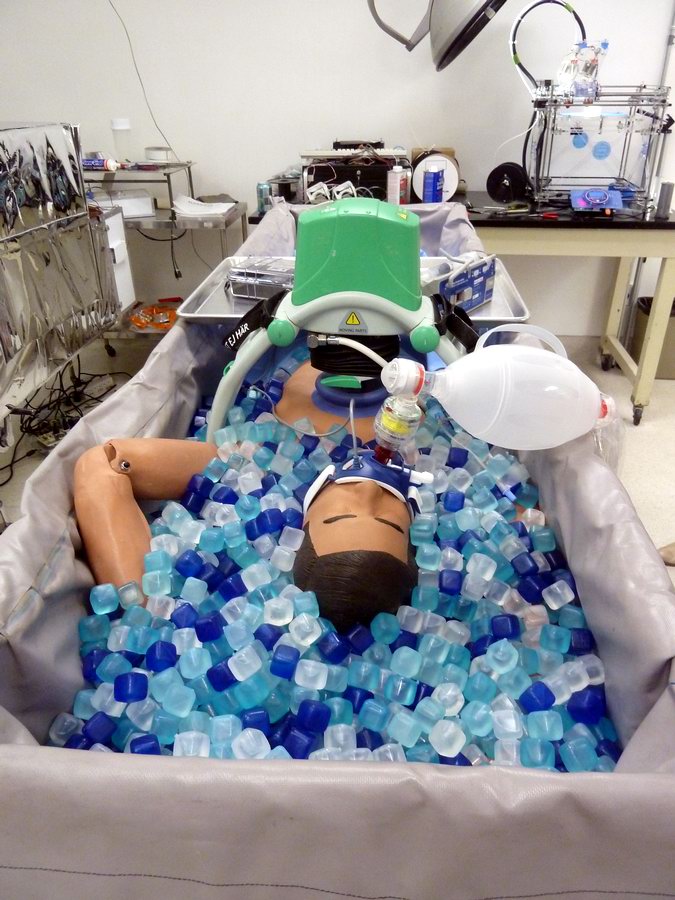Frozen in time: The truth about cryonics
Interview with
In theory, cryopreservation - the process of using low temperatures to preserve  people - is possible, but how would it work in practice? Garret Smyth is one of the first UK residents to sign up for the scheme; he's also the co-founder of the cryonics organisation, Cryonics UK. Cryonics UK have a specially-designed ambulance that cools and prepares patients for shipping to a long term preservation facility in America or Russia. They have been in business for over 5 years and he told Chris Smith how they are process a patient, starting with a specially-prepared ambulance...
people - is possible, but how would it work in practice? Garret Smyth is one of the first UK residents to sign up for the scheme; he's also the co-founder of the cryonics organisation, Cryonics UK. Cryonics UK have a specially-designed ambulance that cools and prepares patients for shipping to a long term preservation facility in America or Russia. They have been in business for over 5 years and he told Chris Smith how they are process a patient, starting with a specially-prepared ambulance...
Garrett - From the outside, it looks like a pretty regular ambulance. Inside, a lot of the stuff is the same, but there's an important piece of equipment, which is a container that can hold ice and water as well as also, so you can put the patient in there. They will, by this point, already have been put on a machine that compresses the chest, and the CPR.
Even though the person is legally dead, the blood is continuing to be circulated so that allows them to cool down quickly. But then as they get down near zero, one has to replace the blood with a medical grade anti-freeze or cryoprotectant as it's called. This has a slightly lower freezing temperature so you can get them down below zero. It also replaces a lot of the water in the cells. So, there isn't a sort of bottle of liquid in a freezer effect of expanding ice. The water comes out of the cells and we would take patients down to dry ice temperature.
Chris - That's about minus 60, isn't it?
Garrett - 78, I think. Then they're flown over to the states or if you choose Russia, where you're brought down to liquid nitrogen temperature. If it's all gone well, in the best of circumstances, you've actually got enough anti-freezing to stop ice crystals forming.
Chris - So, the whole thrust of this is by getting the body temperature right down, really quickly, you reduce the rate at which any kind of decay or degradation of the tissue is going to happen so that they're then placed in this storage facility in liquid nitrogen, nearly minus 200 degrees C which means that they should "survive" in that pristine or as near pristine state as possible, until such time as they can be - well, for want of a better phrase, reanimated.
Is it possible though to store an entire human in this sort of way? Does the tissue not do what happens to a raspberry or a strawberry if dumped in the freezer and just explode?
Garrett - A raspberry and a strawberry are not very good models for animals due to not having a blood supply. Because of the blood supply, you can get very close to every cell in the body and replace - as I was saying - the water with anti-freezers, which stop crystals forming.The biggest thing so far...
Chris - But has anyone actually done this would say - if I took a hamster or a mouse and I anesthetised it and replaced all its body water with one of these cryoprotectants and put it in ultimately liquid nitrogen and then later, thawed it out, can I come up with a viable mouse that way?
Garrett - At the moment, not a mouse. A kidney has been done and it's a rabbit kidney so it's not going to be that big a kidney, but it is a proof of principle of being able to do it.
Chris - So, why hasn't anyone succeeded with a whole organism like a mouse or a hamster or even something bigger?
Garrett - When I say no one has done it with a hamster, as long as you don't get too cold. It has been done with a hamster. Audrey Smith at the Mill Hill Institute in London did it in the 1950s. There always seems to be someone stopping the research. It's very frustrating because really, without much research, it could be done properly and much better.
Chris - Because obviously, that's going to be fundamental to this working because if the current techniques are being employed, but you can't do this on an animal model, then there's not much hope for say, you as the UK's first person to sign up.
Garrett - One aspect of it is research and I entered it knowing fully that it wasn't done perfectly and the situation has improved a lot. They're now doing vitrification rather than freezing, which is a great improvement. They couldn't vitrify kidneys when I first signed up. So, it's an ongoing research and I joined in order to support the research.This is why I'm advocating we really should do more research. So, if you're going to make me wait a thousand years, as long as I'm kept in good condition, I'm willing to take the chance. I was listening to a programme the other day where they were talking about bringing back the dodo using 3D bioprinters and I was thinking, you know, because they can bring about the dodo, I'm going to be easy...
- Previous Back from the dead
- Next You could live forever - as a robot!










Comments
Add a comment